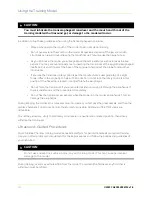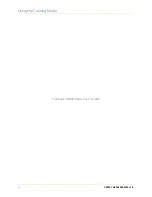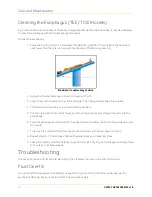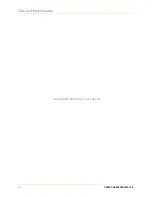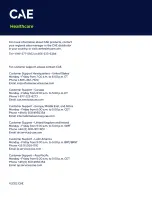
©2022 CAE 905K004752 v1.0
13
Care and Maintenance
Care and Maintenance
With proper care, your training model will remain in optimal condition and ready for use.
Storage and Transport
Follow these guidelines to properly store or transport your model:
• Storage temperature degree range: 45 to 85 °F (7 to 29 °C)
• Store the model as is, or in a CAE Blue Phantom storage case (if available for your model).
• Do not store in contact with other models or hard objects as the pressure can damage the
Simulex tissue. Do not stack multiple training models on top of each other.
• Ensure any tubes are not pinched or compressed under the model. This will damage the tubes
and void the warranty.
• When models with inserts are stored standing up for long periods of time, gravity may cause the
insert to deform slightly. Remove the insert and let it sit for a few days to regain its shape.
• Store the model with some fluid in any vessels and fluid spaces. If these become dry, it will
damage the model and and cause poor ultrasound imaging.
• If fluid was infused into the model during training, remove excess fluid after each training
session. If you store the model with too much fluid inside, it can cause damage.
• Transport the model securely so it does not fall.
• Do not carry by the tubes or use them as handles as this will damage the model.
Cleaning
To maintain the product skin for the lifespan of the product, clean the exterior of the model after each use.
Follow these steps:
1. Mix one cup of tap water with ¼ teaspoon of mild liquid soap (such as dish soap).
2. Gently clean the model’s exterior with the soap mixture and a soft, non-abrasive sponge or
cloth.
3. Rinse lightly with clean water.
4. Dab or pat with a clean, soft, lint-free cloth to dry the product after cleaning. Do not wipe or rub
the skin, which can damage it.
5. After the model has dried completely, lightly coat the external surface of the model with baby
powder and dust off any excess.
Summary of Contents for Blue Phantom Echocardiography and Pericardiocentesis Ultrasound Training Model
Page 1: ......
Page 2: ......
Page 4: ...Contents ii 2022 CAE 905K004752 v1 0 THIS PAGE INTENTIONALLY LEFT BLANK...
Page 10: ...Introduction 6 2022 CAE 905K004752 v1 0 THIS PAGE INTENTIONALLY LEFT BLANK...
Page 16: ...Using the Training Model 12 2022 CAE 905K004752 v1 0 THIS PAGE INTENTIONALLY LEFT BLANK...
Page 20: ...Care and Maintenance 16 2022 CAE 905K004752 v1 0 THIS PAGE INTENTIONALLY LEFT BLANK...
Page 21: ......












